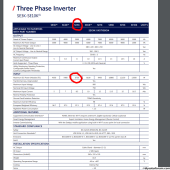NeoX
New Member
So, I'm now at a stage where I'm considering SolarEdge string inverter again over Enphase microinverters. I also read this very interesting topic by @FilterGuy who did an analysis on MPPT controller in series considering bypass diodes and shading. While the topic in the end wasn't conclusive, especially as most panels on offer today have half-cut cells which means the panel is typically split into two, it did make me wonder if I should opt for a string inverter system.
To add some context to my situation:
My aim is to generate the maximum power output possible with minimal future maintenance (replacing/repairing microinverters under warranty whack-a-mole style is not my idea of efficiency). I understand string inverters are more efficient on the AC/DC conversion.
My other concern is that a string inverter must be attuned to the size of the PV array, but there is some scope for oversizing upfront as long as the DC/AC sizing ratio is no more than 73% (3-phase) according to here. In my system, it's unlikely I'll add more than two additional panels in future, and I may upgrade panels to higher Wp panels if any need replacing later, but this is where I really need clarification.
If I'm running a PV array producing 9460 Wp, my supplier recommends an SolarEdge SE10K inverter. This allows for a maximum of 15,000W input, so a lot more than my array produces, and an AC output of 10,000 W total (3333 W per phase). The DC/AC sizing ratio in this case would be 9460/10000 = 94.6%. However, if I go for an SE5K inverter, which has an AC output of 5000 W total, then I would be oversizing the system with a DC/AC sizing ratio of 9460/5000 = 189%.
I had a chat with ChatGPT to get my head around this (search for "I am considering a string inverter" at this link for where this part of the conversation starts), and it said that oversizing allows for greater potential energy capture when my panels are not operating at their maximum capacity (e.g., cloudy days), but that I could lose out on energy capture due to curtailment during peak conditions. So, this complicates the choice further. The SE5K is a lot cheaper than the SE10K, but there's an in-between option with the SE8K where the DC/AC sizing ratio would be 9460/8000 = 118%.
The Netherlands is often cloudy, but it has lots of bright sunny days in the summer in the southern parts where I live. So, I just don't know what would be the most optimal choice. And this is leading me back towards microinverters again so I don't have to think about it.
Any thoughts or insight on the above would be greatly appreciated.
To add some context to my situation:
- An Enphase system roughly adds about 3.3% to the price of the system (comparing top SolarEdge Home Hub to top Enphase microinverter), but can also be as much as 18% if comparing to a more basic SolarEdge system).
- To get as many panels on my roof as possible, I'm going to go for an east-west system, which I understand optimisers will resolve - no need for a dual MPPT (SolarEdge doesn't have this).
- There is a chimney on my roof which will cause shade on one or two panels.
- There is a small "wall" about 15cm high around the edge of my roof.
My aim is to generate the maximum power output possible with minimal future maintenance (replacing/repairing microinverters under warranty whack-a-mole style is not my idea of efficiency). I understand string inverters are more efficient on the AC/DC conversion.
My other concern is that a string inverter must be attuned to the size of the PV array, but there is some scope for oversizing upfront as long as the DC/AC sizing ratio is no more than 73% (3-phase) according to here. In my system, it's unlikely I'll add more than two additional panels in future, and I may upgrade panels to higher Wp panels if any need replacing later, but this is where I really need clarification.
If I'm running a PV array producing 9460 Wp, my supplier recommends an SolarEdge SE10K inverter. This allows for a maximum of 15,000W input, so a lot more than my array produces, and an AC output of 10,000 W total (3333 W per phase). The DC/AC sizing ratio in this case would be 9460/10000 = 94.6%. However, if I go for an SE5K inverter, which has an AC output of 5000 W total, then I would be oversizing the system with a DC/AC sizing ratio of 9460/5000 = 189%.
I had a chat with ChatGPT to get my head around this (search for "I am considering a string inverter" at this link for where this part of the conversation starts), and it said that oversizing allows for greater potential energy capture when my panels are not operating at their maximum capacity (e.g., cloudy days), but that I could lose out on energy capture due to curtailment during peak conditions. So, this complicates the choice further. The SE5K is a lot cheaper than the SE10K, but there's an in-between option with the SE8K where the DC/AC sizing ratio would be 9460/8000 = 118%.
The Netherlands is often cloudy, but it has lots of bright sunny days in the summer in the southern parts where I live. So, I just don't know what would be the most optimal choice. And this is leading me back towards microinverters again so I don't have to think about it.
Any thoughts or insight on the above would be greatly appreciated.




